Key Takeaways
- Web2 social media monopolize web traffic, and Web3 brings some variables that put users ahead of product development. Meanwhile, social media giants are entering the NFT space and are trying to integrate it with their own business models.
- NFTs and social media have a symbiotic relationship, and the former can be used as a weapon for social media expansion.
- During the journey from Web2 to Web3, information distribution and organizational structure will undergo changes, and Web3's social product features will be upgraded accordingly. For example, SBT-based personal social station and SocialFi customization.
- Web3 introduces a decentralized information distribution model and an immersive interactive experience that will provoke new thoughts on socializing.
1.Web3: The Next Opportunity for Social Media
Social media dominate data traffic in Web2. Facebook, YouTube, Twitter, and TikTok have created different information flow models that have given rise to new industries, businesses, and professions, thus leading to an upgrade in consumption and a huge amount of money flowing to these social media giants.
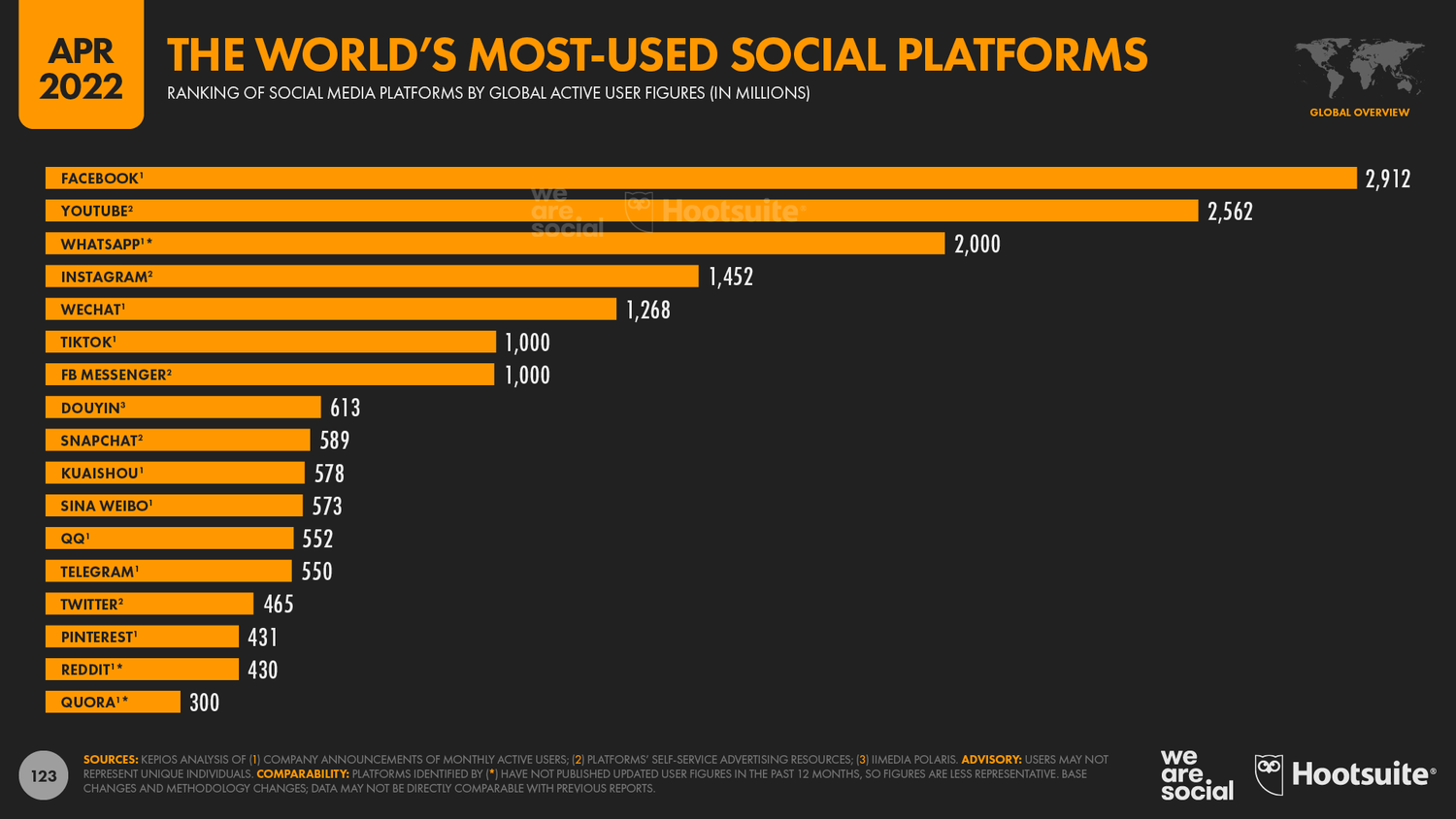
So far, the main strategy on social media has shifted from "product optimization" to "content is king". Also, news feed ads have become the primary business model, which monetizes user attention and data. However, this model has also caused a number of problems. How can we balance users, data security and commercialization of attention? As for creators of this era, they have to rely on platforms to survive with content being the king—which to a certain extent lacks plausibility.
The development of blockchain has introduced some interesting concepts such as SocialFi, NFTs, DAOs, etc. With the advantages of data autonomy and decentralization, the crypto industry has gradually cultivated new user awareness: a Web3 user culture characterized by open information, cultural freedom and community autonomy.
Traditional social media giants know that Web3 will be the next critical opportunity, but due to their size and regulation issues, they are only able to take baby steps.
This time, Web3 users are getting ahead of products.
Let's find out what Web2 companies have attempted to do.
2. Clash of Giants
2.1 Twitter
Needless to say, Twitter is where most of the current information about NFTs comes from. It has been interested in including crypto as a major part of its future business since Jack Dorsey set up a team specifically for NFT. Furthermore, Twitter was the first social media platform to allow its users to use NFTs as profile pictures and to support multiple crypto wallets.
It is worth mentioning that Twitter attempted to launch its own NFT last year, but the effort didn't come to fruition. According to insiders, Twitter's upcoming plan is to strengthen its influence on the NFT community.
2.2 Meta
After renaming to Meta, Facebook has made it clear about their goal of becoming the world's largest social media metaverse. Following Twitter's footsteps, Meta announced its plan to build an NFT ecosystem that enables using NFTs as profile pictures on both Facebook and Instagram. In addition to that, Meta hopes to simplify the process of trading digital assets by using its payment infrastructure to support a marketplace for NFTs.
2.3 Instagram
Instagram has recently launched an NFT showcasing feature that enables connection to digital wallets, NFT identification, and proof of NFT holders. Zuckerberg stated that in the next few months, Instagram will allow users to bring their NFTs onto the platform and will further explore the possibility of minting NFTs. It is apparent that its primary audience is creators and collectors.
2.4 TikTok
TikTok partnered with Immutable X last year to launch TikTok Top Moments, a collection consisting of trending videos created by community-defining creators. Proceeds will largely go directly to the creators and NFT artists involved.
The company has also partnered with Audius, a music NFT platform, to develop TikTok Sounds, a new feature that allows Audius users to export their NFTs to TikTok. The feature is created in the hope of making TikTok a social platform that rewards creators with innovative means.
2.5 YouTube
YouTube, the world's largest online video sharing platform, has been exploring the integration of NFTs with the creator economy. Animal Concerts CEO Colin Fitzpatrick describes such integration as "a great way for creators to earn a profit without relying on ads." Plus, Susan Wojcicki, CEO of YouTube, has stated that the company will "employ technologies such as NFTs to enhance user experience for creators and their fans."
2.6 Reddit
After Twitter launched its NFT avatar feature, Reddit also launched its own NFT collection last year. According to a previous job posting, it seems that Reddit is interested in building its own NFT marketplace, making the platform one of the most active in expanding into Web3.
Another thing is that Reddit's internal data for 2021/2022 show 85% of its users are more NFT-savvy than the average internet user. This result is well above Twitter users at 39% and Instagram users at 17%.
These social media companies have all made their own moves into Web3. The common denominator is that they are trying to integrate NFTs with their current business models. For instance, Twitter started with NFT avatars because its users tend to socialize and carry out discussions; Instagram launched its showcasing feature because its users prefer sharing their statuses and pictures. TikTok and YouTube, on the other hand, have always had reward schemes, which is why they find ways to integrate NFTs with the creator economy.
3. The Social Media-NFT Relationship
3.1 Symbiosis
Getting users from social media is still prevalent in Web3: community fission, KOL collaboration, and media promotion—all require initial funding for user subsidies. Simply put, community fission refers to the process of a new users referral program by original users, where points and incentives will be given out. Besides, collaborations with KOLs are also generally used for blind advertising.
With that said, do NFT promotion's feel very similar to what's mentioned above? NFT project creators today still rely on social media to convey their values. They usually announce what they did and what they're going to do on Twitter and Discord. This creates a rather bizarre phenomenon: Web3 NFT value presentation are dependent on Web2 social media, which also leads to the most critical issue—NFT value promotion is inseparable from social media. To put it in an exaggerated way, if Twitter doesn't validate a project, its creators and developers will suffer value damage.
Of course, there are alternatives, and social media platforms should use this to proactively associate their value with Web3. By attracting more project creators, they will be able to expand their territory in the Web3 space.
Here comes the question: how do we create strong ties that will enable expansion into Web3?
3.2 Expansion
Although NFTs and social media have a symbiotic relationship, there's always been a state of competition between different platforms. Therefore, whoever dominates the NFT world gets to be the next megacorp.
We are still in the initial phase of development. As we can see, these social media giants are still experimenting with their own products, and have yet to become competitive. In the subsequent expansion phase, social media platforms will most likely launch their own NFTs to attract users. Not only is this a great way to accurately identify user demographics, but it is also the best means to retain users, who will also get to enjoy social media services by holding NFTs.
Used as a weapon of expansion, NFTs possess a high destruction power. Here are several possible directions we can explore.
(1)From Social Activity to Cultural Output
NFT holders form a community through discourse consensus and identity, and defend the interests of the community by voicing their opinions on social media. From a sociological point of view, human beings gather, communicate, and finally generate group consciousness that leads to the birth of "culture" in a narrow sense. Therefore, community culture represented by NFTs becomes a powerful strength of social media, and such culture can be spread through trading. By doing so, social media platforms will form a positive cycle to grow their own user base.
(2)Expanding the Ecosystem with Pass
All the while, traditional social media has been working on acquiring more customers and using them as bargaining chips to negotiate with businesses for collaboration. One feasible way is to issue NFTs and attract project creators and communities to join with passes. The advantage of this is that it allows social media to quickly build its own NFT ecosystem in Web3, not only to acquire users from other projects, but also to expand the rights of its own users and improve their retention rate.
(3)Seizing the Content High Ground (NFT Copyrights)
IP of quality content has always been a key in Web2. In a similar sense, NFTs by quality creators and quality communities will determine the final winner. This is why we see many social media platforms cultivating the soil of content production for NFT creators' platforms and NFT markets. As for communities, their interests are tied together with the platform through collaborations that allow for interactions. The results are expected to expand the platforms' ecosystem and secure their chances in NFT content development, which ultimately leads to a bigger user base.
4. Envisioning Web3 Social Media
4.1 Changes in Information Distribution Model
One of the most fundamental differences between Web2 and Web3 social media is the difference in the information distribution model. We are very familiar with personalized content recommended by algorithms. This content is produced through PGC and UGC, and shown to users through a centralized social media platform.
In Web3, information dissemination is more oriented to social recommendation. Following the six degrees of separation, people become the central node of information distribution. Creators distribute content and NFTs to fans through their DAOs, and token rewards will be made through smart contracts in this process.
Naturally, there will be a transition period going from Web2 to Web3, which is where we are right now: Web2.5. It is a stage of convergence consisting of social media, DAOs, Web2 users and Web3 users. This stage is characterized by a gradual weakening of the power of platforms which are replaced by DAOs packed with content and culture. Platforms attract creators and users through NFTs, then creators share their content and interact with fans by holding NFTs issued by the platform. Gradually, Token incentive design and DAO governance will be incorporated, allowing everyone to create, distribute, and quantify values.
The following diagram illustrates the different information distribution models that evolve over time.
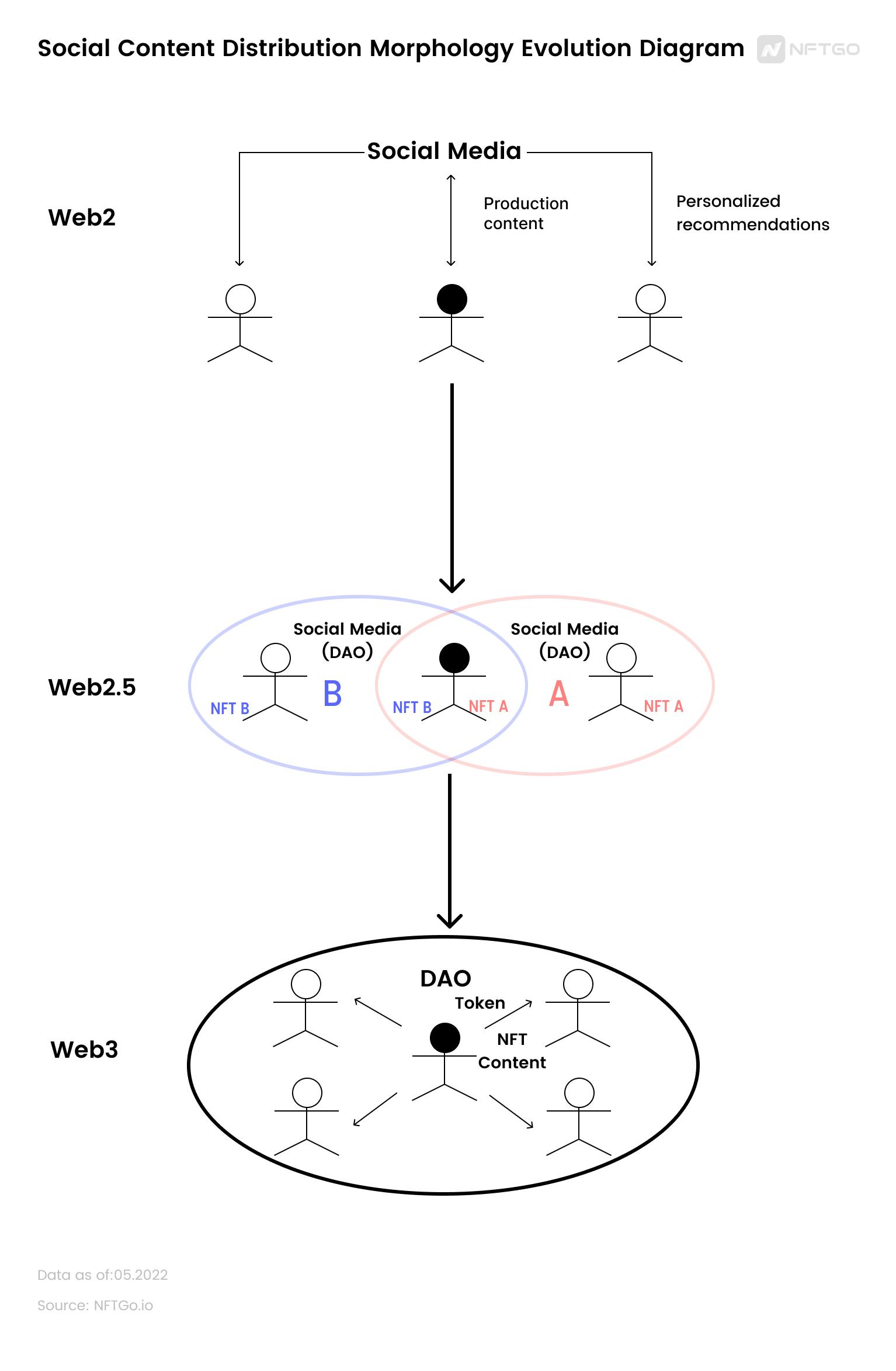
4.2 Comparison of Web2 and Web3 Social Media Characteristics
Socializing in Web3 no longer relies on social platforms. Instead, everyone becomes the hub of content distribution. With a unified personal account and complete freedom of personal data, social interactions are recorded in your own ecosystem. Besides, protocols like Lens Protocol have been establishing a social platform based on accounts.
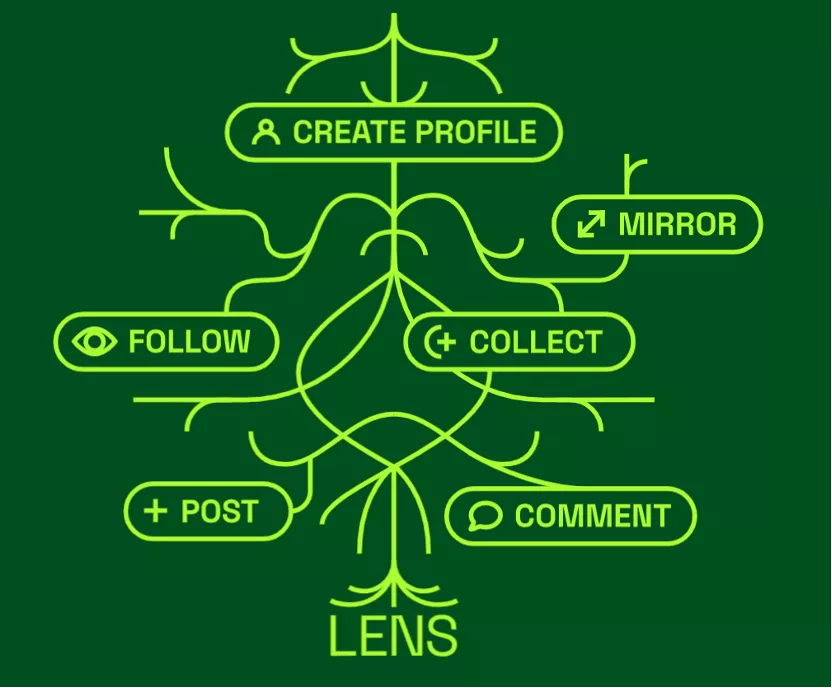
In addition to the protocol layer, the application layer has also witnessed some changes. Some SocialFi projects such as Monaco Planet, BitClout, and OneOf provide wallet verification, NFT registration, and token rewards for interaction, thus completing some of the basic functions of SocialFi. However, these projects remain siloed and have different reward methods. Perhaps, people can build their own social platform through SocialFi integration. Since every individual has a different social style, users can select SocialFi plans that fit their needs.
4.3 The Content Distribution Power
Many people believe that giving a platform the power to control user data and to decide what users see is not entirely bad. Without these platforms, we wouldn't be able to filter information efficiently, making interesting content harder to come by. This has always been insurmountable for users, because humans are self-contradictory—we want to have maximum choices, yet we also want to get information directly and conveniently.
After decentralization has been achieved through NFTs and DAO, people have the need to reclaim their social attributes. For example, some DAOs on Discord have many meetings and activities every day. In fact, it is much more realistic than conventional social media as it requires people to network in order to obtain information. Users have to seek good content and interesting people instead of conforming to commercially recommended information.
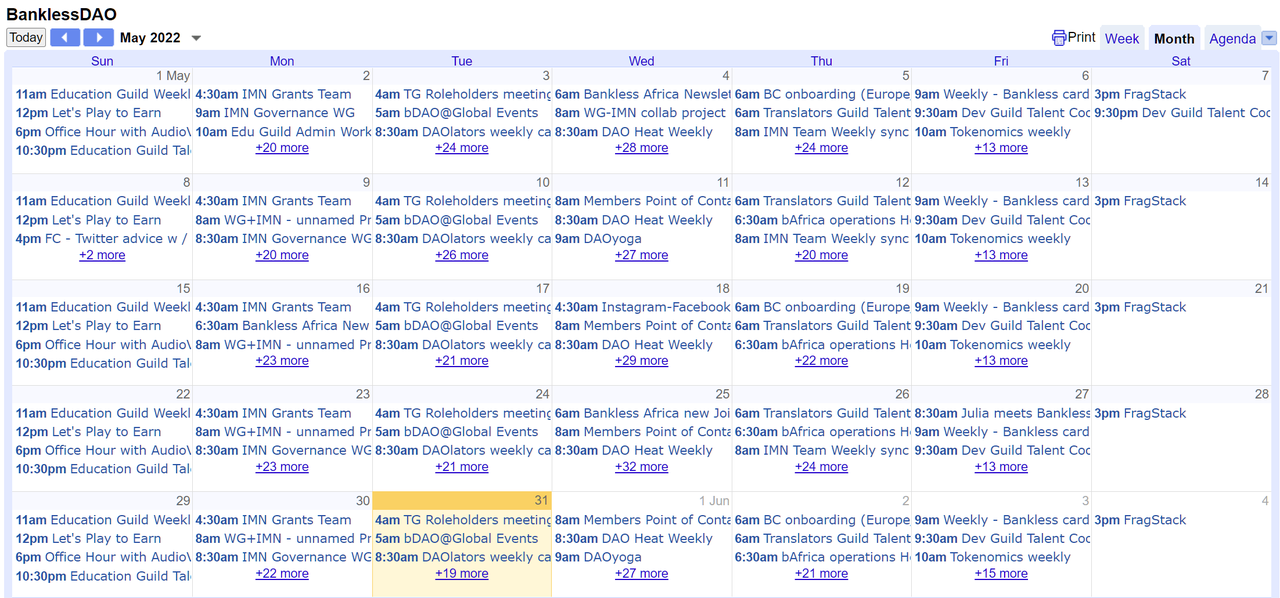
Social Experiences in Web3
In addition to the mechanisms of SocialFi and DAO, another major problem is the complexity of the interface and the crudeness of interaction, which is why some traditional social media companies probe into Web3 by improving the interactive experience of social media. Companies like Meta are now dedicated to developing an interactive 3D experience. In the future, immersive and interactive user experience will become the main battleground for Web3 social media.
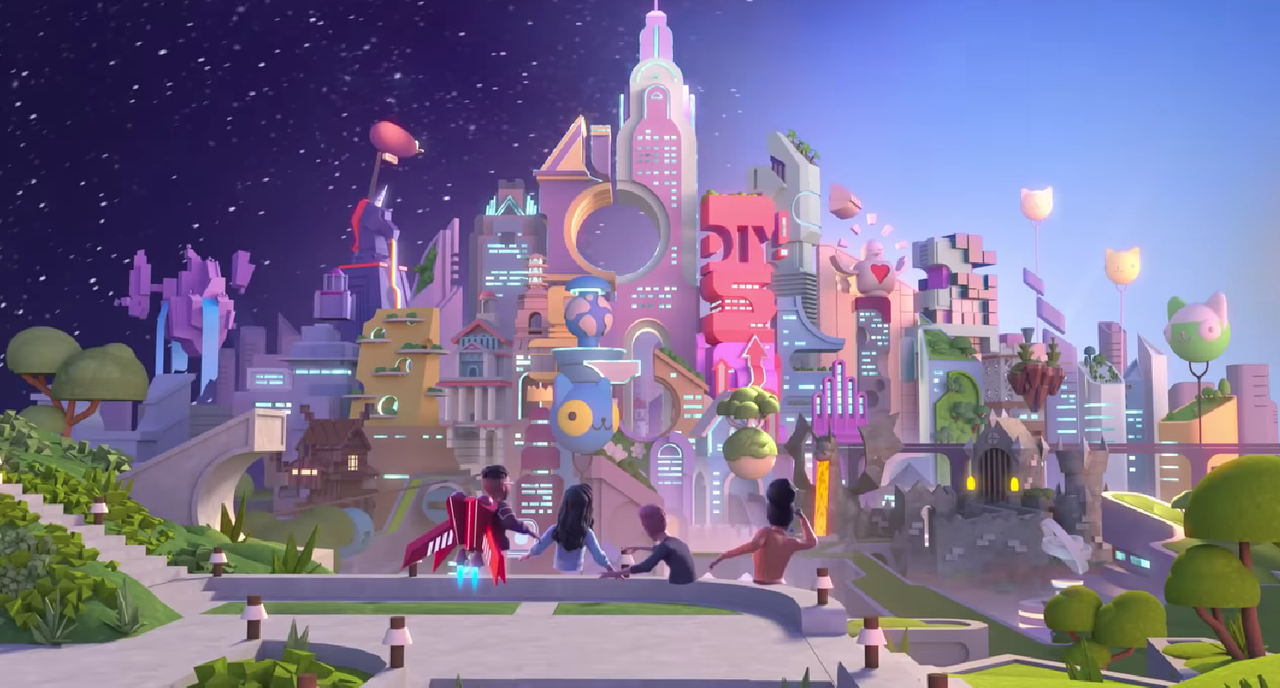
In addition, the SocialFi concepts of Web3 social media currently encompass various tracks including the metaverse, gaming, and the creator economy. Their competitors are not just other social media, but also projects based on the metaverse such as The Sandbox and Otherside. Therefore, this means Web3 interactive experience is bound to develop alongside the metaverse.
Conclusion
SocialFi, DAO, and NFTs have provided room for imagination with applications. This is a golden opportunity for social media dedicated to Web3, but not necessarily one for traditional Web2 social media as the industry has entered a period of slow growth. Seeing the rapid emergence and development of Web3 social products, traditional social media will only face bigger challenges.
Apparently, the way of self-help is to bind interests with Web3 through NFTs so as to obtain a Web3 user base and prevent it from being eliminated from the market. At the same time, using NFT's as a weapon is the only way to form a threat to competitors. Whether it is launching their own NFTs, issuing passes, holding quality projects, or opening up new markets, starting first and early will allow them to win over competitors.
In the foreseeable future, content distribution models and interactive experiences will undergo changes. Only when these scenarios happen can we officially determine the commencement of the Web3 era: when NFTs and DAOs are fully integrated into the SocialFi system, when the metaverse takes shape, and when people rethink and redefine the term "social media". By then, the term will also become history.